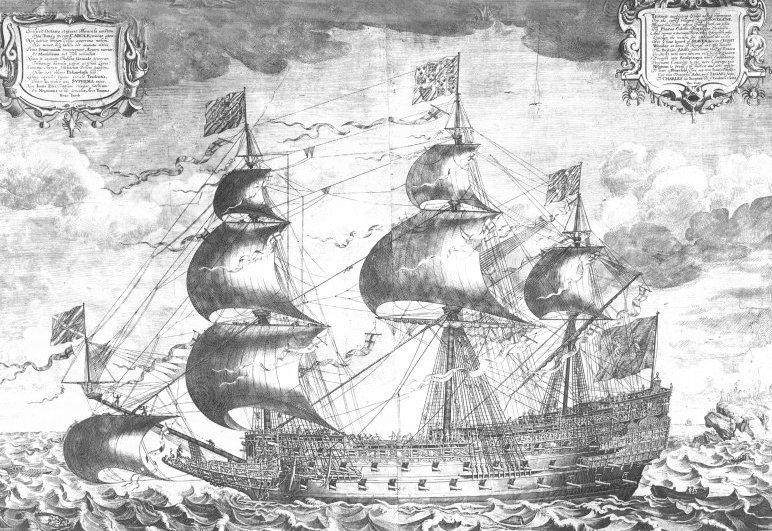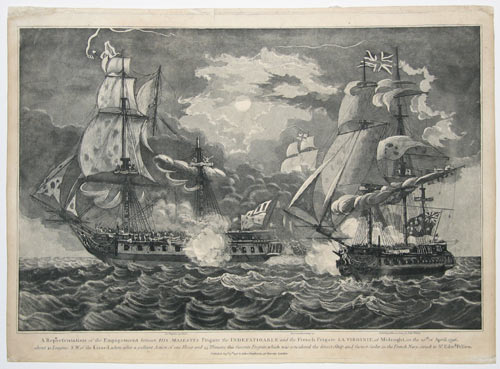razee on:
[Wikipedia]
[Google]
[Amazon]
A razee or razée is a
 During the transition from
During the transition from
sailing ship
A sailing ship is a sea-going vessel that uses sails mounted on Mast (sailing), masts to harness the power of wind and propel the vessel. There is a variety of sail plans that propel sailing ships, employing Square rig, square-rigged or Fore-an ...
that has been cut down (''razeed'') to reduce the number of decks. The word is derived from the French ''vaisseau rasé'', meaning a razed (in the sense of shaved down) ship.
Seventeenth century
 During the transition from
During the transition from galleon
Galleons were large, multi-decked sailing ships developed in Spain and Portugal.
They were first used as armed cargo carriers by Europe, Europeans from the 16th to 18th centuries during the Age of Sail, and they were the principal vessels dr ...
s to more frigate
A frigate () is a type of warship. In different eras, the roles and capabilities of ships classified as frigates have varied.
The name frigate in the 17th to early 18th centuries was given to any full-rigged ship built for speed and maneuvera ...
-like warships (1600 – 1650) there was a general awareness that the reduction in topweight afforded by the removal of upperworks made ships better sailers; Rear Admiral
Rear admiral is a flag officer rank used by English-speaking navies. In most European navies, the equivalent rank is called counter admiral.
Rear admiral is usually immediately senior to commodore and immediately below vice admiral. It is ...
Sir William Symonds noted after the launch of ''Sovereign of the Seas'' that she was "cut down" and made a safe and fast ship. In 1651 ''Sovereign of the Seas'' was again made more manoeuvrable by reducing the number of cannon
A cannon is a large-caliber gun classified as a type of artillery, which usually launches a projectile using explosive chemical propellant. Gunpowder ("black powder") was the primary propellant before the invention of smokeless powder during th ...
. Ships were razeed not only by navies but also by pirate
Piracy is an act of robbery or criminal violence by ship or boat-borne attackers upon another ship or a coastal area, typically with the goal of stealing cargo and valuable goods, or taking hostages. Those who conduct acts of piracy are call ...
s – Captain Charles Johnson
Captain Charles Johnson was the British author of the 1724 book ''A General History of the Pyrates, A General History of the Robberies and Murders of the most notorious Pyrates'', whose identity remains a mystery. No record exists of a captain b ...
's ''A General History of the Pyrates
''A General History of the Robberies and Murders of the most notorious Pyrates'', or simply ''A General History of the Pyrates'', is a 1724 book published in Britain containing biographies of contemporary pirates,George Lowther refitting ''Gambia Castle'' in 1721:
This did not reduce the number of gun decks, but had the effect of making the razee ship much handier, since the
 In the
In the

 In the
In the
forecastle
The forecastle ( ; contracted as fo'c'sle or fo'c's'le) is the upper deck (ship), deck of a sailing ship forward of the foremast, or, historically, the forward part of a ship with the sailors' living quarters. Related to the latter meaning is t ...
and aftcastle no longer created windage
In aerodynamics, firearms ballistics, and automobiles, windage is the effects of some fluid, usually air (e.g., wind) and sometimes liquids, such as oil.
Aerodynamics
Windage is a force created on an object by friction when there is relative m ...
, top weight was reduced, and the ship was made lighter overall.
Eighteenth and early nineteenth centuries
Royal Navy
 In the
In the Royal Navy
The Royal Navy (RN) is the naval warfare force of the United Kingdom. It is a component of His Majesty's Naval Service, and its officers hold their commissions from the King of the United Kingdom, King. Although warships were used by Kingdom ...
, the razee operation was typically performed on a smaller two-deck ship of the line
A ship of the line was a type of naval warship constructed during the Age of Sail from the 17th century to the mid-19th century. The ship of the line was designed for the naval tactics in the Age of Sail, naval tactic known as the line of battl ...
, resulting in a large frigate
A frigate () is a type of warship. In different eras, the roles and capabilities of ships classified as frigates have varied.
The name frigate in the 17th to early 18th centuries was given to any full-rigged ship built for speed and maneuvera ...
. The rationale for this apparent reduction in gun power was that the smaller ships-of-the-line could no longer be used safely in fleet actions as the overall size and armament of opposing ships increased. The resulting razeed ship was classed as a frigate; it was stronger than the usual run of purpose-built frigates.
In similar fashion, three-decked ships of the line were sometimes razeed, either to become flush-decked (with the quarterdeck
The quarterdeck is a raised deck behind the main mast of a sailing ship. Traditionally it was where the captain commanded his vessel and where the ship's colours were kept. This led to its use as the main ceremonial and reception area on bo ...
and forecastle removed) or cut down to become two-deckers.
was a 90-gun second rate launched in 1756. She was razeed as a 74-gun third rate
In the rating system of the Royal Navy, a third rate was a ship of the line which from the 1720s mounted between 64 and 80 guns, typically built with two gun decks (thus the related term two-decker).
Rating
When the rating system was f ...
in 1805.
Three 64-gun ships were cut down (razeed) in 1794 into 44-gun frigates. The most successful was HMS ''Indefatigable'' which was commanded by Sir Edward Pellew
Admiral Edward Pellew, 1st Viscount Exmouth, GCB (19 April 1757 – 23 January 1833) was a Royal Navy officer and politician. He fought during the American War of Independence, the French Revolutionary Wars, and the Napoleonic Wars. His younge ...
.
* HMS ''Magnanime'' of 1780
* HMS ''Anson'' of 1781
* HMS ''Indefatigable'' of 1784
Towards the close of the Napoleonic Wars, three elderly 74-gun ships were razeed into 58-gun fourth rates (not losing a complete deck, so remaining a two-decker, but having the quarterdeck removed). Two more followed immediately post-war, although the second never completed conversion.
* HMS ''Goliath'' of 1781 (razeed 1813)
* HMS ''Majestic'' of 1785 (razeed 1813)
* HMS ''Saturn'' of 1786 (razeed 1813)
* HMS ''Elephant'' of 1786 (razeed 1817-18)
* HMS ''Excellent'' of 1787 (began razee 1825)
Another eleven more-recent 74s were razeed in 1826-1845, in this case being fully reduced to 50-gun heavy frigates; three others were scheduled for similar conversion, but this was never completed.
* HMS ''Barham'' of 1811 (razeed 1826)
* HMS ''Dublin'' of 1812 (razeed 1826)
* HMS ''Asia'' of 1811 (renamed HMS ''Alfred'' 1819 and razeed 1826-28)
* HMS ''Cornwall'' of 1812 (razeed 1827-30)
* HMS ''America'' of 1810 (razeed 1827-28)
* HMS ''Conquestador'' of 1810 (razeed 1827-31)
* HMS ''Rodney'' of 1809 (renamed HMS ''Greenwich'' 1826 and began razee conversion 1827, but never completed it)
* HMS ''Clarence'' of 1812 (renamed HMS ''Centurion'' 1826 and began razee conversion 1827, but never completed it)
* HMS ''Cressy'' of 1810 (began razee conversion 1827, but never completed it)
* HMS ''Vindictive'' of 1813 (razeed 1828-32)
* HMS ''Eagle'' of 1804 (razeed 1830-31)
* HMS ''Gloucester'' of 1812 (razeed 1831)
* HMS ''Warspite'' of 1807 (razeed 1837-40)
* HMS ''Tremendous'' of 1784 (renamed HMS ''Grampus'' 1845 on completing razee conversion)
French razée warships (Revolutionary War conversions)
In the French navy, a number of 74-gun two-deckers were similarly razeed into 54-gun ships: * ''Diadème'' (renamed ''Brutus'' in September 1792 and razeed between December 1793 and May 1794) * ''Hercule'' of 1778 (razeed between February and June 1794, then renamed ''Hydre'' in May 1795) * ''Argonaute'' of 1781 (razeed between December 1793 and March 1794, then renamed ''Flibustier'' in June 1794) * ''Illustre'' of 1781 (razeed between August 1793 and February 1794, renamed ''Mucius Scevola'' in January 1794, name shortened to ''Scevola'' in February 1794) * ''Brave'' of 1781 (razeed between April 1793 and January 1794, without change of name) * ''Borée'' of 1785 (renamed ''Ça Ira'' in April 1794, then again ''Agricola'' in June 1794 and razeed between April and July 1794) * ''Agamemnon'' of 1812United States razee warship
* USS ''Independence'' of 1814Late nineteenth century

 In the
In the United States Navy
The United States Navy (USN) is the naval warfare, maritime military branch, service branch of the United States Department of Defense. It is the world's most powerful navy with the largest Displacement (ship), displacement, at 4.5 millio ...
, several of the final generation of sailing frigates launched in the 1840s were cut down to become large sloops-of-war. Advances in metallurgy
Metallurgy is a domain of materials science and engineering that studies the physical and chemical behavior of metallic elements, their inter-metallic compounds, and their mixtures, which are known as alloys.
Metallurgy encompasses both the ...
and artillery
Artillery consists of ranged weapons that launch Ammunition, munitions far beyond the range and power of infantry firearms. Early artillery development focused on the ability to breach defensive walls and fortifications during sieges, and l ...
in the 1850s allowed the casting of guns
A gun is a device that propels a projectile using pressure or explosive force. The projectiles are typically solid, but can also be pressurized liquid (e.g. in water guns or cannons), or gas (e.g. light-gas gun). Solid projectiles may be ...
that fired substantially heavier shot than had previously been in use, as well as exploding shells. Thus, when the decision was made to rearm these frigates with heavier but fewer guns, the reduction in crew
A crew is a body or a group of people who work at a common activity, generally in a structured or hierarchy, hierarchical organization. A location in which a crew works is called a crewyard or a workyard. The word has nautical resonances: the ta ...
size allowed the ships to be razeed. Their sail plan
A sail plan is a drawing of a sailing craft, viewed from the side, depicting its sails, the spars that carry them and some of the rigging that supports the rig. By extension, "sail plan" describes the arrangement of sails on a craft. A sailing c ...
and size made them superb sailers. Although these ships carried a heavier broadside as 20 gun sloops-of-war than they did as 40 gun frigates, they were rerated as nominally smaller sloops-of-war because they mounted fewer guns. Such ships include USS ''Macedonian'' and USS ''Cumberland''.
References
{{Sailing vessels and rigs Naval sailing ship types Nautical terminology Naval warfare History of the Royal Navy